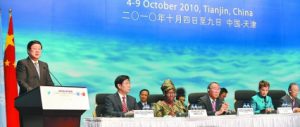Last month’s UN-led climate talks in Cancún, Mexico, were largely touted as a success, as countries reached near consensus on critical issues such as technology transfer and the creation of a new Green Climate Fund to help developing countries adapt to global warming. The standing ovation for the Mexican hosts that erupted in the summit’s final plenary session came in stark contrast to the conclusion of last year’s Copenhagen talks, which ended behind doors, closed to civil-society observers.
Another marked change in Cancún was China’s tone and communication strategy, following heavy criticism at, and after, Copenhagen.
Whether the finger-pointing was valid or not, Copenhagen was a watershed event for China. In the run-up to the summit, Beijing put forth a voluntary commitment to reduce carbon intensity by 40% to 45% by 2020, compared to 2005 levels, breaking with precedent of avoiding specific emission targets. By making this pledge, as well as by recognising that it would not be first in line to receive financial assistance from developed countries for adaptation and mitigation measures, China stepped into a leadership role. Despite these efforts, the country’s relative lack of experience in climate diplomacy meant it still walked away as Copenhagen’s scapegoat.
“China was surprised by the emphasis on MRV [measurement, reporting, and verification of emissions reductions] in Copenhagen and the negative media attention it received, since it felt like it had brought a lot to the table by agreeing to reduce its carbon intensity and taking significant steps to improve energy efficiency and renewables,” said Alvin Lin, China climate and energy policy director at US environmental group the Natural Resources Defense Council.
Transparency of emissions data has been a key sticking point for the United States in climate negotiations. In Copenhagen, US delegates, including secretary of state Hillary Clinton and senator John Kerry, insisted that major emerging economies like China and India must be transparent about their emissions information before the United States would enact climate legislation and provide climate aid. Backed into a corner, China reluctantly agreed to international consultation and analysis (ICA) of its climate pledges – a less stringent version of MRV required of developed countries.
And so one lesson China took from Copenhagen was that it needed to improve its climate diplomacy and revamp its image, if it was to avoid shouldering further blame – particularly if the Cancún talks “failed”. The government started by releasing domestic media accounts that portrayed China’s role in Copenhagen as positive and constructive. Then, in October, China hosted its first UN Framework Convention on Climate Change (UNFCCC) conference in Tianjin. The intersessional meeting in the lead-up to Cancún was a prime opportunity for China to showcase itself and reaffirm commitment to the UNFCCC process. But, while Tianjin provided Chinese media and NGOs with ample training ground, eyes were really turned to Cancún, waiting to see how China would respond after the previous year’s public-relations fiasco.
How did China’s strategy change in Mexico? First, it stepped out of the limelight, assuming a much lower profile than it had in Copenhagen. In Denmark, China joined other countries in setting up a pavilion in the Bella Convention Centre, where experts gave lectures and senior members of the negotiation team held daily press conferences. But amongst Cancún’s pavilions – including stands from not just the United States and the European Union, but also first-timers like India and Qatar – China’s was notably absent.
Second, the Chinese negotiation team made concerted efforts to speak in much softer tones in Cancún. A New York Times article pointed out that Chinese negotiators avoided mention of the United States by name, instead “obliquely” referring to it as an “Annex I country that is not a party to the Kyoto Protocol”: a far cry from the Sino-US blame game that erupted in Tianjin. The language was so soft that major media organisations started prematurely reporting that the United States and China were close to brokering a deal on MRV, before the two delegations had actually met.
China also took a new approach to communicating its negotiation stance on key issues, particularly on transparency. In Copenhagen, Chinese officials had appeared elusive when they opposed MRV on grounds of violating the country’s national sovereignty. But in the lead-up to Cancún, Chinese officials decided to be forthcoming. An article in chinadialogue quoted Xie Zhenhua, vice minister of China’s National Development and Reform Commission (NDRC) and the head of the Chinese delegation, as saying in strong, clear terms that “China will be transparent.”
Chinese civil-society organisations also contributed to efforts to refashion the country’s image in Cancún. A coalition of China-based NGOs was active in organising side events and distributing materials that showcased China’s climate success stories. Student-led initiatives between US and Chinese youth emphasised the need to build trust based on dialogue and mutual understanding. And Chinese and US-based NGOs, taking their cue from the youth collaborators, met and formalised a long-term action plan for cooperative action. Meanwhile, the private Chinese company Broad Air Conditioning demonstrated its sustainable building technologies at an off-site “Chinese pavilion” that was marked on shuttle-bus maps – and even confused by some for an official Chinese government pavilion.
Chinese media organisations also worked hard to portray China positively in Cancún, helped by the negotiation team’s efforts to make themselves available for interviews in the build-up to the conference. The China Daily, for instance, produced two 16-page glossy specials that were distributed during the first and second weeks of the summit, covering various aspects of China’s actions on climate change, such as efforts to promote low-carbon growth in cities, and including commentaries by foreign experts on international collaboration on clean energy.
Li Xing, assistant to the China Daily’s editor in chief, said Cancún was the first time the newspaper had published special climate conference reports: “I was in Copenhagen covering the climate talks last year. During that conference, quite a few papers, including the Financial Times and Japan Times, published special reports.
“In contrast, there was very little coming from China, except fliers at the China booth. That is why we thought of making China more understandable to the outside world here at Cancún. It is largely China Daily’s own initiative, but it does fit in with the wider government initiative to make China better understood in the world.”
The process to revamp China’s climate-communication strategy has, however, suffered inevitable growing pains. Several news articles during Cancún’s first week suggested China was still being misunderstood. A Reuters piece created a lot of excitement when it misreported that China had announced willingness to submit its voluntary emission-reduction targets to an internationally binding process – a “game-changing move”, according to many observers. But senior Chinese officials were quick to refute the claims and clarify that China’s position had not changed.
Huang Huikang, special representative for climate change at China’s Ministry of Foreign Affairs, who was quoted in the media reports, recognised the gaffe and told a group of young people from China and the United States that there were still translation issues when it came to speaking to foreign media. He pointed to the dual-edged nature of the press: while contributing to transparency and trust-building, it can also sensationalise and report inaccuracies.
China’s nascent climate diplomacy will only prove more critical for China in the build up to the next major climate meeting in Durban, South Africa, a period during which the international climate regime could significantly change for China. As Cancún failed to determine the legal form of the new climate agreements or to resolve what to do when the first commitment period of the Kyoto Protocol expires in 2012 – two key questions for China and other major developing countries – China will be faced with a particularly difficult conundrum: to be more conciliatory as in Cancún or to hold ground as in Copenhagen. Then in Durban, the new climate diplomacy of the world’s largest greenhouse-gas emitter may be tested once more.
Angel Hsu is a PhD candidate at the Yale School of Forestry and Environmental Studies and represented the Yale Climate and Energy Institute as a COP-16 Fellow in Cancun. Zhao Yupu is a Master of Environmental Science candidate, also at the Yale School of Forestry and Environmental Studies.
Homepage image from IISD shows the opening ceremony of the Tianjin climate summit.


